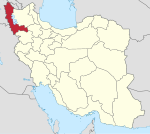Shahin Dezh
Shahin Dezh
Persian: شاهيندژ | |
|---|---|
City | |
 General view of Bibi Kand rock complex | |
| Coordinates: 36°40′50″N 46°34′05″E / 36.68056°N 46.56806°E / 36.68056; 46.56806[1] | |
| Country | Iran |
| Province | West Azerbaijan |
| County | Shahin Dezh |
| District | Central |
| Population (2016)[2] | |
| • Total | 43,131 |
| Time zone | UTC+3:30 (IRST) |
Shahin Dezh (Persian: شاهيندژ and Azerbaijani: سایینقالا,[3] Kurdish: ساین قەڵا, romanized: Sayin Qella, also Romanized as Shāhīn Dezh; also known as Şā’īn Dezh, Shahindej, and Sahin Dazh; formerly, Sāīn Kale, صائین قالا and Şā’īn Qal‘eh,[4] is a city in the Central District of Shahin Dezh County, West Azerbaijan province, Iran, serving as capital of both the county and the district.[5]
At the 2006 census, its population was 34,204 in 8,671 households.[6] The following census in 2011 counted 38,396 people in 10,782 households.[7] The latest census in 2016 showed a population of 43,131 people in 12,826 households.[2]
Shahin Dezh is located about 1,300 meters in elevation. The city is on the Zarrineh River, southeast of Lake Urmia.
History
The modern town of Shahin Dezh was formerly known as Ṣāʾīn Qal‘eh.[8] The name Ṣāʾīn (also spelled Sāīn, Shahin, etcetera.) is derived from the Mongol sayin, which translates as "good".[8]
The local Turkic Afshars were brought to the area from Shiraz at the beginning of the 19th century by Fath-Ali Shah Qajar (r. 1797–1834), the second shah of Qajar Iran.[8] Later, a segment of these Afshars had to migrate to Urmia in order to make way for the Chardawri (Chardowli) Lurs.[8] The chief of the Chardowli's resided at Mahmuddjik and was the commander of c. 5,000 men.[8] In 1830, Ṣāʾīn Qal‘eh was sacked by Kurds led by Sheikh Ubeydullah.[8] Ṣāʾīn Qal‘eh, being the site of an Iranian military garrison in the past, safeguarded the entrance to the Azerbaijan Province through the Zarrineh valley.[8]
The ancient Karaftu caves, first described by Robert Ker Porter (1777–1842), and the old site of Takht-e Soleyman were formerly located in the territory of the Afshars of Ṣāʾīn Qal‘eh.[8] The lake of Chamli Göl, near the village of Badarli with its floating island were likewise well known at the time.[8] Some of the Afshars of Ṣāʾīn Qal‘eh belonged to the Yarsanism sect.[8]
The old site of Ṣāʾīn Qal‘eh is now occupied by the modern town of Shahin Dezh, which is also the chef-lieu of Shahin Dezh County. In c. 1950, its population was 3,170 which by 1991 had increased to 25,050.[8]
The fortress of Ṣāʾīn Qal‘eh must not be confused with the similarly named fortress on the Abhar river to the east of Soltaniyeh, which was mentioned by Hamdallah Mustawfi (1281 – after 1339/40).[8]
References
- ^ OpenStreetMap contributors (19 February 2024). "Shahin Dezh, Shahin Dezh County" (Map). OpenStreetMap. Retrieved 19 February 2024.
- ^ a b "Census of the Islamic Republic of Iran, 1395 (2016)". AMAR (in Persian). The Statistical Center of Iran. p. 04. Archived from the original (Excel) on 30 August 2022. Retrieved 19 December 2022.
- ^ Aseman: منطقهای که مرکز آن تکاب است و معروف به یوخاریمحال (محال علیا) و منطقه دیگر را که مرکز آن سایین قالا یا همان شاهین دژ فعلی است آشاقیمحال (محال سفلی) مینامند
- ^ Shahin Dezh can be found at GEOnet Names Server, at this link, by opening the Advanced Search box, entering "-3081937" in the "Unique Feature Id" form, and clicking on "Search Database".
- ^ Habibi, Hassan (24 September 1369). "Creation and establishment of two cities and several districts and annexation of several villages to Urmia city". Research Center of the System of Laws of the Islamic Council of the Farabi Library of Mobile Users (in Persian). Ministry of Interior, Defense Political Commission of the Government Board. Archived from the original on 23 February 2014. Retrieved 20 December 2023.
- ^ "Census of the Islamic Republic of Iran, 1385 (2006)". AMAR (in Persian). The Statistical Center of Iran. p. 04. Archived from the original (Excel) on 20 September 2011. Retrieved 25 September 2022.
- ^ "Census of the Islamic Republic of Iran, 1390 (2011)". Syracuse University (in Persian). The Statistical Center of Iran. p. 04. Archived from the original (Excel) on 20 January 2023. Retrieved 19 December 2022.
- ^ a b c d e f g h i j k l Minorsky, V. (1997). "Ṣāʾīn Ḳalʿa". In Bosworth, C. E.; van Donzel, E.; Heinrichs, W. P. & Lecomte, G. (eds.). The Encyclopaedia of Islam, Second Edition. Volume IX: San–Sze. Leiden: E. J. Brill. ISBN 978-90-04-10422-8.
External links
- Images from this city

